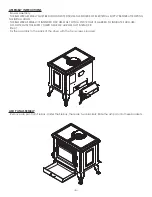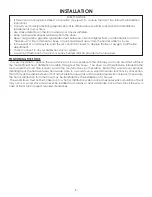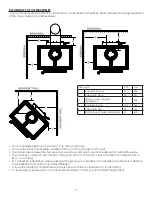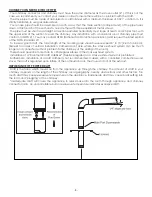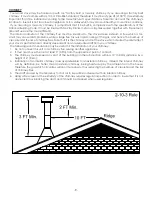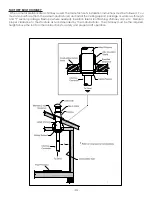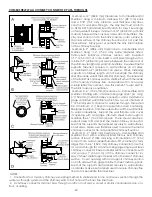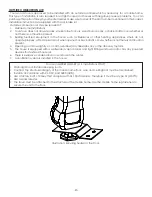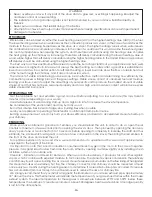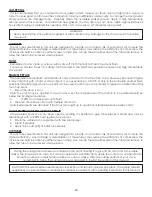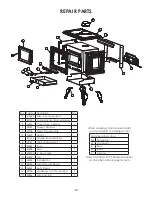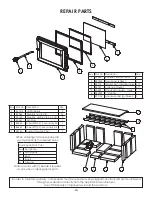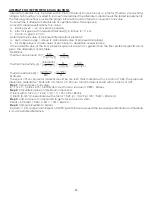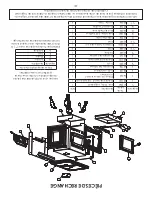
-15-
TESTING YOUR WOOD
When the stove is thoroughly warmed, place one piece of split wood (about five inches in diameter) parallel to
the door on the bed of red embers.
Keep the air control full open by pulling on it and close the door. If ignition of the piece is accomplished within
90 seconds from the time if was placed in the stove, your wood is correctly dried. If ignition takes longer, your
wood is damp.
If your wood hisses and water or vapor escapes at the ends of the piece, your wood is soaked or freshly cut.
Do not use this wood in your stove. Large amounts of creosote could be deposited in your chimney, creating
potential conditions for a chimney fire. Tamper Warning
This wood heater has a manufacturer-set minimum low burn rate that must not be altered. It is against federal
regulations to alter this setting or otherwise operate this wood heater in a manner inconsistent with operating
instructions in this manual.
THE FIRST FIRES
The fresh paint on your stove needs to be cured to preserve its quality. Once the fuel charge is properly ignited,
only burn small fires in your stove for the first four hours of operation. Never open the air control more than
necessary to achieve a medium burn rate.
Make sure that there’s enough air circulation while curing the stove. The odors could be smelled during the 3 or
4 first fires. Never start your stove outside. You will not be able to see if you are over heating.
IGNITION
After making sure that the stove air intake controls are fully open (completely pull-out towards you), The top
down method of fire building is recommended for this appliance. After making sure that the stove air intake
controls are fully open (completely pull-out towards you), Place the largest pieces of wood on the bottom, laid in
parallel and close together. Smaller pieces are placed in a second layer, crossways to the first. A third layer of still
smaller pieces is laid crossways to the second, this time with some spaces between. Then a fourth layer of loose,
small kindling and twisted newspaper sheets tops off the pile.
Before igniting the paper and kindling wood, it is recommended that you warm up the chimney. This is done
in order to avoid back draft problems often due to negative pressure in the house. If such is the case, open a
window slightly near the stove and twist together a few sheets of newspaper into a torch. Light up this paper
torch and hold it as close as possible to the mouth of the pipe inside the combustion chamber to warm up the
chimney. Once the updraft movement is initiated, you are ready to ignite the stove by lighting the paper and
kindling wood inside the combustion chamber.
When you have achieved a good bed of hot embers, we recommend the following burn procedures:
Primary Air Settings
(Slide Damper is located in center of stove under hearth
plate)
(Damper Adjustment: Pulling out on damper increases
air)
Electric Blower Speed Setting (Variable)
(Blower is on High when turned “ON”,
Rotate clockwise until stop for “LOW”.)
Burn Rate
Adjust Damper from fully closed
Burn Time
Blower Speed
Low
1/4” (6.3mm)
@ 30 minutes
Low
Medium - Low
3/8” (9.5mm)
@ 30 minutes
Low
Medium - High
1/2” (12.7mm)
@ 30 minutes
Low
High
approx. 3” (76mm)
all minutes
High
CAUTION: Never alter the damper slide or the adjustment range to increase firing for any reason. Doing so could result in
heater damage and will void your warranty.
HEATING
Controlled combustion is the most efficient technique for wood heating because it enables you to select the type
of combustion you want for each given situation. The wood will burn slowly if the wood stove air intake control is
adjusted to reduce the oxygen supply in the combustion chamber to a minimum. On the other hand, wood will
burn quickly if the air control is adjusted to admit a larger quantity of oxygen in the combustion chamber. Refer
to the primary air settings table for damper operation setting. Real operating conditions may give very different
results than those obtained during testing according to the species of wood used, its moisture content, the size
and density of the pieces, the length of the chimney, altitude and outside temperature.
Summary of Contents for AWC31
Page 24: ... 24 NOTES ...




